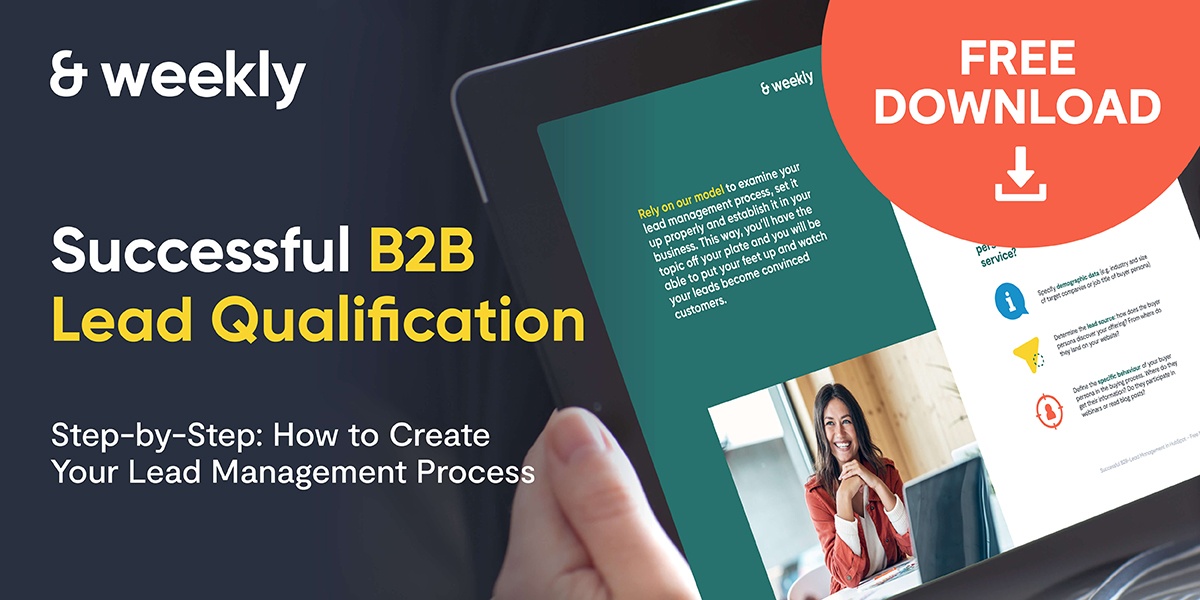Which marketing metrics are significant in inbound marketing and how can you best track them? We’ve compiled the top 11 metrics covering the most important goals in inbound marketing.
Why You Should Measure Inbound Marketing
Back in 2005, HubSpot founders Brian Halligan and Dharmesh Shah identified a significant trend in B2B buyer behaviour. A few years later, in their book entitled “Inbound Marketing”, they laid out the fundamentals of this marketing strategy, which has continued to shape how the majority of B2B companies structure their marketing to this day.
Nowadays, most B2B buyers conduct their own research – initially without any personal contact with a supplier. Parts of or even the entire B2B buying process take place online, which is why the targeted use of content marketing is paramount. After all, content tailored precisely to the buyer’s journey serves as a touchpoint with customers and leads prospects step by step along the marketing funnel.
However, one mistake many businesses make is generating expensive content without measuring whether it actually achieves the desired results. Not every company will use the same inbound marketing measures. Moreover, content formats need to be used in a targeted manner and in coordination with the overarching marketing strategy. Only those who know what they want to achieve will select the right inbound measures. And only those who measure these activities using the right metrics will know whether their actions have been successful or not.
How to Measure Inbound Marketing
Before you start measuring your inbound strategies, you should first establish which goal (or goals – you don’t have to limit yourself to one!) you are seeking to achieve. The measures or the appropriate content formats will then be built on this. If you want to drive brand awareness, for example, you’ll need a wide reach and so should focus more on SEO and lead generation. If your goal is to boost sales figures, email marketing with an excellent product offering is a fantastic way to position yourself better.
Once your goals are set, the following metrics will help you keep track of your progress. We’ve created a list of 11 key inbound metrics for you – organised according to relevant inbound goals.
SEO goals
If you can nail SEO on the head, you’ll definitely enjoy a large reach and increasing brand awareness. Use these metrics to measure whether your content gets the attention it deserves.
-
Keyword ranking
Using the right keywords will ensure you occupy the top positions in the ranking results. Corresponding keyword search engines help you to find the best search phrases that will elevate your content right to the top. These include Google Search Console, Ahrefs and Ubersuggest.
-
Traffic and traffic sources
If you want to monitor whether your website is actually found and visited, then traffic metrics are for you. You’ll see which subpages are popular, which is particularly important when it comes to thinking about your blog posts. You can see the number of visits in the Google Search Console, as well as find out the source of the traffic to your pages.
-
Backlinks
Website A refers to website B via a hyperlink. Website B then says “thank you” by linking back to website A (backlink). If your website is backlinked on lots of other websites, this indicates to Google that your website is highly relevant and will have a positive impact on your ranking. It goes without saying that these should be high-quality backlinks, although it doesn’t matter whether they are linked to your homepage or sub-pages.
Engagement
One of the most important currencies in the online world is engagement. As a result, the figures concerning community engagement are absolutely vital. Keep an eye on these metrics:
-
Interactions
Whether it’s shared content, comments or mentions, social media simply doesn’t work without user interaction. Look at the insights from each platform to see which posts, topics and formats work best.
-
Dwell time (time on page)
How long visitors spend on your page tells you whether they find your content relevant and interesting and whether it offers solutions to their pain points. Google Analytics provides you with insights into this and other data. If you created your website using HubSpot, you’ll find more information about dwell time directly under Reporting.
Email marketing
Whether it’s newsletters or product emails – the golden ticket to increasing your conversion rates is capturing your customers’ attention. Keep the following figures in mind as you monitor the success of your measures:
-
Open rate and unsubscribe rate
The open rate forms the basis of your analysis. If an email is not opened, there is nothing to measure. You can of course seek to improve this by trying out new subject lines. If you have a high unsubscribe rate, it’s prudent to allow unsubscribers to give a reason as to why they did so. This way, you can better respond to the wishes of your target group and make appropriate adjustments where necessary.
-
Click-through rate (CTR)
This metric tells you which products or content your readers would like to learn more about. Pay particular attention to placing relevant links and CTAs to redirect visitors and generate conversions where appropriate.
Lead generation
Acquiring new leads is high on the priority list in inbound marketing. In this regard, it would be true to say that many roads lead to Rome. With the following metrics, you can always keep an eye on whether your marketing campaigns are generating the desired results.
-
Lead quantity and quality
When it comes to lead generation, many think in terms of the quantity. A large pool of leads looks great in the statistics and shows which channels work best for you. But as is often the case in life, quality plays a more significant role in converting leads into customers in the long run. In this regard, lead scoring can be used to assess lead quality.
-
MQL to SQL
This metric also refers to lead quality and looks at which marketing leads are converted into sales leads. The result informs you whether your lead management strategy is working or whether some restructuring is necessary if too few MQLs are converting.
Conversions
Converting leads into customers is the primary goal of every sales funnel. Although inbound marketing is primarily concerned with the phases before the deal is closed, looking at direct sales and customer loyalty also supplies information about where content marketing can help you close more deals. The following metrics will help you do this:
-
Retention vs. churn
The churn rate is a crucial metric when it comes to analysing your customer base, especially with regard to subscriptions. A high churn rate should always be investigated more closely, as the reasons are often many and varied. To tackle possible churn, content marketing can provide additional information that both supports your customer service team and offers answers to potential questions and solutions to common problems.
-
New vs. returning visitors
The returning visitors metric reveals how helpful your leads find the content you provide. Especially for products or solutions that require some explanation or involve a large initial investment, this metric shows that interested users are keeping an eye on your offering.
Tools for Measuring Inbound Marketing Metrics
Selecting the right tools and technologies is crucial for efficiently tracking and analysing inbound marketing metrics. Here are some of the key tools that can help you achieve your marketing goals:
- Google Analytics: An essential tool for tracking website traffic, visitor sources, and user behaviour. It provides comprehensive insights into your website's performance and helps identify optimisation opportunities.
- HubSpot: An all-in-one platform for inbound marketing that offers features for lead generation, email marketing, social media management, and CRM. HubSpot allows you to create detailed reports and dashboards to monitor the effectiveness of your campaigns.
- SE Ranking: A powerful SEO tool that enables keyword research, competitor analysis, and backlink tracking. It helps you improve your website's visibility in search engines and find the right keywords.
- Ahrefs: Another comprehensive SEO tool that provides detailed information on backlinks, keyword rankings, and content performance. Ahrefs is particularly useful for analysing competitors' SEO strategies and optimising your own.
- Mailchimp: A popular platform for email marketing that allows you to create and manage newsletters and automated email campaigns. Mailchimp offers detailed analytics on open rates, click-through rates, and unsubscribe rates.
- Google Search Console: A free tool from Google that provides insights into your website's performance in Google Search. It helps you track search queries, clicks, impressions, and average ranking positions.
By combining these tools, you can get a comprehensive view of your inbound marketing performance and make informed decisions to optimise your strategy.
Examples of KPI Dashboards for Tracking Inbound Marketing Metrics
KPI dashboards are valuable tools for clearly presenting key inbound marketing metrics and tracking the progress of your marketing efforts in real-time. Here are some examples of KPI dashboards you can use:
- Website Traffic Dashboard: This dashboard shows the number of visitors, traffic sources, most popular pages, and average time on site. It helps you assess the effectiveness of your SEO and content marketing strategies.
- Lead Generation Dashboard: Track the number of leads generated, the sources of leads (e.g., organic, social, paid), conversion rates, and lead quality. This dashboard provides insight into the performance of your lead generation efforts.
- Email Marketing Dashboard: This dashboard shows open rates, click-through rates, unsubscribe rates, and conversion rates of your email campaigns. It helps you analyse and optimise the effectiveness of your email marketing strategies.
- Social Media Engagement Dashboard: Track interactions on your social media channels, including likes, shares, comments, and mentions. This dashboard gives you insights into which content resonates most with your audience and how to increase engagement.
- SEO Performance Dashboard: This dashboard shows your keyword rankings, the number and quality of backlinks, organic traffic numbers, and search engine visibility. It helps you assess and adjust the effectiveness of your SEO strategies.
- Sales Funnel Dashboard: Track the number of MQLs, SQLs, conversions, and the average time to close a deal. This dashboard provides insight into the efficiency of your sales funnel and helps you identify and address bottlenecks.
By using these KPI dashboards, you can ensure that you always have a clear overview of the performance of your inbound marketing efforts and make informed decisions to optimise your strategy. Want more B2B marketing tips? Click here to see all our blog posts.






